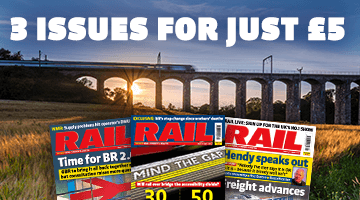 Peer review: Nick Gallop
Peer review: Nick Gallop
Managing Director, Intermodality Ltd
The latest research, as outlined in Philippa’s article, makes another valuable contribution to a debate that shows no sign of immediate resolution.
The rail industry has long argued for a “level playing field” with road haulage and having hosted a workshop in Brussels earlier this year as part of a project for the European Commission on encouraging greater mode shift of freight from road, it is clear that opinions remain deeply divided.
Proponents of rail argue that without the Grail-like level playing field, rail and intermodal services will struggle to compete with road haulage. The road lobby responds that lorries will nearly always be needed to make the first and last part of a freight journey and that even with the best will in the world, the rail network simply doesn’t have the capacity to carry the majority of freight traffic.
Yet the “road vs rail” debate starts to unravel when you then try to discuss how best to combine (rather than substitute) the various modes of transport to mutual benefit.
On the one hand, ‘pure’ rail freight services - moving large volumes of product between rail-linked sites (for example, aggregates from quarries to urban railheads) - may be less concerned about the economics of road haulage, as the relative costs and logistics of moving several thousand tonnes of freight in one train compared with up to 100 lorries will usually see rail winning out. The fears that the introduction of 44-tonne lorries would wipe out rail freight services proved to be wide of the mark for this very reason.
On the other hand, most of the growth in Network Rail’s latest rail freight forecasts is expected to come from the intermodal sector, where road haulage will be needed at either or both ends of the rail haul. These local collection and delivery trips by lorry make a significant dent in the overall economics of intermodal freight services, against the equivalent door-to-door road haulage price.
In the short term, it is difficult to see how the costs of rail freight could be made significantly cheaper, given that track access charges are already based on the marginal (rather than full) costs of wear and tear. And as Philippa notes, Government continues to provide revenue support for intermodal and other rail freight services (with little way of really knowing whether or not the train operators genuinely need such support). So if the costs of road haulage were then to increase, that dent in the economics of intermodal freight then gets larger.
Heavier and longer lorries bring similar challenges, with the debate generating emotive epithets from detractors, such as “juggernauts”, “mega-trucks” and “gigaliners”, compared with the more warm and fuzzy “European modular concept” used by supporters of longer trucks.
The basic issue is this: if you use a container or swap body to move freight, you will be carrying several tonnes of extra tare weight in the road mode (the container and road trailer weigh more than a standard road trailer), which then eats into your payload, particularly if you’re moving bulk goods.
The UK briefly tried offering hauliers involved in rail freight an extra three tonnes of extra gross weight to overcome this. But the derogation was soon cancelled when the authorities realised (by accident or design – you be the judge) that they couldn’t effectively police the derogation, so the entire industry got the extra three tonnes instead.
Those promoting longer and/or heavier lorries say that this would make the costs of road haulage to and from railheads come down, as fewer lorry trips would be required. Not so fast, says the rail freight industry - this will then make general road haulage more cost-effective, meaning rail will struggle even more to compete. So the debate is unresolved.
Polarising the issues into quasi-pantomime heroes and villains risks missing out on pragmatic solutions, such as Malcolm Group’s inspired decision to use the current UK trials of longer semi-trailers to allow use of longer swap bodies by road - and by rail.
With the UK “blessed” with a fleet of intermodal wagons with 16 metre decks (as BR thought the Channel Tunnel would make us all go continental and start using pairs of short swap bodies - which we didn’t), each time a wagon carries a standard 13.6m-long swap body, that’s over 2m of wasted deck space. It doesn’t sound much, but multiply that by more than 30 times (as most intermodal trains now do), and that’s a big waste of space in terms of the extra swap bodies that could have been carried in the same length of train. But rather than bemoan road hauliers being given another carrot, Malcolm Group now uses the same carrot on rail, too. Simples!
Stepping outside of the ring, the overall challenge must surely be to make logistics as sustainable as possible, minimising the overall level of resources needed to move a given volume of goods (I’m going to conveniently side-step the wider issue of where and how those goods are resourced and manufactured, as there are only so many hours in the day).
This will increasingly mean making use of multiple modes of transport in combination. So any solution for infrastructure charging in one mode will need to avoid unintended consequences in encouraging the right mix of other modes. Philippa notes the apparent success of developments in Germany and the Czech Republic in promoting behavioural change in the use of road haulage and rail freight, suggesting that these problems may not be insuperable.
The European White Paper on Transport notes that “a transformation of the European transport system will only be possible through a combination of manifold initiatives at all levels”. It’s hard to disagree with the sentiment. In North America, intermodal rail freight has seen a dramatic turnaround in fortunes since the 1980s, with a virtually bankrupt and dysfunctional rail sector transformed into a key player in the overland freight market, where legislation is now focused on limiting its scope for market dominance. It’s apparent that Europe (where rail’s market share is around half that in North America) still has a long way to go, and there is no denying that a solution to the challenges of infrastructure charging needs to be found - if nothing else, it can achieve a simple charging mechanism, which avoids the need for further grants and subsidies (and attendant administrative costs) to act as sticking plasters.
Beyond this, achieving a step-change in rail freight use will need its own combination of manifold initiatives – better service quality, faster or higher-capacity trains (and perhaps more dedicated lines for them to run on), quicker border crossings, and more rail freight interchanges. We perhaps need to become more successful at being more North American than any of the North Americans that have tried so far over here (Wisconsin Central, Thrall, Parsec, NDX…)











